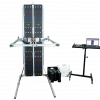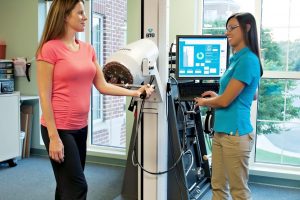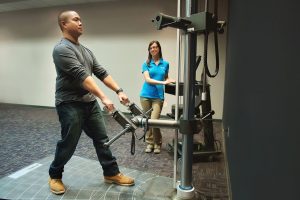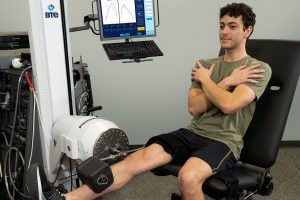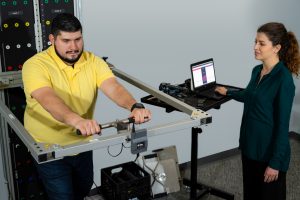
Endurance Testing Tools in Physical Therapy: Quantifying Speed, ROM, Resistance
Treatment GuidelinesRegardless of the activity the individual is trying to return to, endurance is a prime consideration for tasks which require repeated movement at a submaximal level. This is an important component of function since the majority of muscles must work continually during most activities.
Endurance testing tools are essential in physical therapy to measure and improve a patients’ ability to perform physical activities over time. These tools help clinicians objectively evaluate speed, range of motion, and resistance to track patient progress and tailor treatment plans. Here, we’ll explore how endurance testing tools are used to quantify and enhance performance in your physical therapy practice.
How To Measure Endurance in Physical Therapy
Endurance testing in physical therapy is more than just observing a patient’s stamina. It involves quantifiable metrics that provide insights into their physical capabilities. With endurance testing tools, physical therapists can scientifically measure functional endurance, set baselines, and track progress over time.
Functional Endurance Testing Tools
Functional endurance testing tools are designed to evaluate the ability to perform specific repetitive activities. These specialized testing tools are likely used in clinics that specialize in injured worker rehabilitation, or other scenarios that require very specific task simulation. These tools provide accurate data, making it easier to identify areas for improvement.
A lightweight, portable option for functional testing tools is the EVJ. With the EVJ, you can objectively test and track strength, ROM, and functional capacity of the upper and lower extremities and cervical spine. For a more complete evaluation system, the Prism allows you to perform precise, functional capacity testing in your clinic or at a client’s jobsite. Its built-in protocols are FCE-ready, with customizable tests, variables, and reporting.
Set a Baseline with Objective Measurement
The first step in endurance testing is establishing a baseline. Tools like hand-held dynamometers and digital goniometers allow therapists to measure initial strength, ROM, or resistance thresholds. An objective baseline measurement not only highlights the patient’s current capabilities but also serves as a reference point for evaluating improvements.
Track Progress with Repeat Testing
Endurance testing tools are invaluable for conducting repeat tests to track patient progress. Rehabilitation therapists can compare data over time to assess improvements. Periodically repeating endurance testing can help keep patients engaged throughout their recovery and determine when a person can safely return to their desired activities or job tasks.
Commonly Used Assessments for Endurance Testing
Physical assessments using endurance testing tools are tailored to each patient’s needs. These methods combine objective measurement with your clinical judgement to evaluate strength, endurance, and overall performance.
Testing Strength
When testing endurance, it’s common to start by measuring maximum strength. Tools like hand-held dynamometers are commonly used to measure how long a patient can sustain a muscle contraction or repetitive motions. Comparing the strength of a muscle group in the injured limb to the same muscle group in the non-injured limb is key to documenting strength loss. By using endurance testing tools, physical therapists can measure both the immediate and the sustained strength capacity of specific muscle groups.
Strength Testing vs Endurance Testing
While strength testing focuses on the maximum force a muscle can exert, endurance looks at how long that strength lasts before fatigue. For example, a handgrip dynamometer can measure peak grip strength (strength testing), while repeated squeezes measure grip endurance. Using objective endurance testing tools ensures accuracy in differentiating these two metrics.
Common Functional Endurance Tests
Other widely used endurance tests include the six-minute walk test and the step test. These simple tests often involve tools like pedometers to measure steps or timers to record duration.
Endurance Testing Variables: Speed, ROM, Resistance
Endurance testing tools help measure critical variables that contribute to physical endurance. When testing muscle endurance, it’s important to control the parameters of the test, including speed, range of motion, and resistance. You should test both sides (injured vs non-injured or dominant vs non-dominant) under similar conditions.
- Speed: Tools like treadmills or a timing cycle metronome can keep the patient’s speed consistent. Speed metrics help track cardiovascular and muscular endurance improvements.
- Range of motion (ROM): Goniometers and motion analysis tools quantify the extent of movement during repetitive exercise. Tracking ROM is essential for ensuring functional performance without compromising joint health.
- Resistance: Dynamometers, force gauges, and load cells measure how much force a person exerts during activity. Weighted machines allow you to increase the resistance and observe the patient’s performance. Resistance-based endurance testing is especially effective for patients building muscular stamina.
Evidence-based Endurance Testing Tools for Your Clinic
Endurance testing tools are essential for accurately measuring physical performance of repetitive tasks. The right tools will help you collect objective data, track progress over time, and tailor the treatment plan. Whether you’re looking for portable, hand-held measurement tools or an all-encompassing functional capacity evaluation system, BTE’s Evaluation and Testing Tools help support your clinical decisions with objective data. Explore our full line of specialized evaluation products:
- EvalTech: Functional testing system that provides comprehensive objective evaluations for hospitals or clinics
- Prism: Transportable testing system for pre-hire or return to work evaluations in the clinic or on job sites
- Evaluator: Portable testing device for clinicians to perform functional evaluations at different locations
- EVJ: Customize your own portable assessment tool set for objective strength and range of motion testing
With precise and objective measurement, endurance testing tools can yield reliable results and help your clients achieve their goals.

